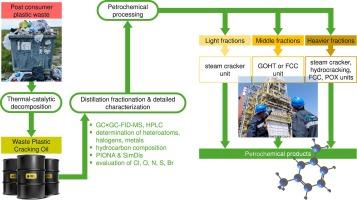针对石化作业的废塑料裂化油进行专业分馏和深度分析
IF 5.9
3区 工程技术
Q1 CHEMISTRY, MULTIDISCIPLINARY
Journal of Industrial and Engineering Chemistry
Pub Date : 2025-05-08
DOI:10.1016/j.jiec.2025.05.012
引用次数: 0
摘要
废塑料裂解油(WPCO)目前被认为是石化/炼油行业潜在的绿色原料,以促进化学回收。然而,WPCO是一种非常复杂的材料,不符合石化工艺的限制。为了评估使用WPCO作为原料的可能性,对来自工业的两个宽沸WPCO样品进行了全面的分析表征和蒸馏。在典型范围内沸腾的馏分:石脑油(30-180°C),重石脑油(30-250°C),中间馏分(180-350°C)和常压残渣(> 350°C)。此外,其他蒸馏切割是通过每10 wt%作为单独馏分蒸馏而制备的。我们对参数在小分数中的分布进行了研究。WPCO-1的芳烃含量随沸点升高而升高,WPCO-2的芳烃含量随沸点升高而降低。与WPCO-1相比,WPCO-2的烷烃和终沸点(FBP)较低。没有一种蒸馏切割不适合在蒸汽裂解装置上“单独”加工而不进行额外处理。然而,一些得到的馏分可以与标准原料协同处理。本研究使人们了解WPCO材料及其作为石化原料的可能性和局限性。本文章由计算机程序翻译,如有差异,请以英文原文为准。

Specialized fractionation combined with deep analytics of waste plastic cracking oils for petrochemical operations
Waste plastic cracking oils (WPCO) are currently being considered as potential green feedstock for petrochemical/refinery industries in order to promote chemical recycling. However, the WPCO is a very complex material that does not meet the limits of petrochemical processes. In order to assess the possibility of using WPCO as raw material, a comprehensive analytical characterization and distillation of two wide-boiling WPCO samples from the industry was performed. Fractions boiling in typical ranges were prepared: naphtha (30–180 °C), heavy naphtha (30–250 °C), middle distillate (180–350 °C), and atmospheric residue (> 350 °C). Moreover, other distillation cuts were prepared by distilling every 10 wt% as a separate fraction. We performed a study on the distribution of parameters in narrow fractions. The content of aromatics increased with the boiling temperature in the cases of WPCO-1, but decreased for WPCO-2. WPCO-2 had lower alkanes and final boiling point (FBP) compared to WPCO-1. None of the distillation cuts are suitable for “stand-alone” processing on the steam-cracker without additional treatment. However, some of the obtained fractions could be co-processed with a standard feedstock. This study brings an understanding of WPCO material and the possibilities and limitations of its use as petrochemical input.
求助全文
通过发布文献求助,成功后即可免费获取论文全文。
去求助
来源期刊
CiteScore
10.40
自引率
6.60%
发文量
639
审稿时长
29 days
期刊介绍:
Journal of Industrial and Engineering Chemistry is published monthly in English by the Korean Society of Industrial and Engineering Chemistry. JIEC brings together multidisciplinary interests in one journal and is to disseminate information on all aspects of research and development in industrial and engineering chemistry. Contributions in the form of research articles, short communications, notes and reviews are considered for publication. The editors welcome original contributions that have not been and are not to be published elsewhere. Instruction to authors and a manuscript submissions form are printed at the end of each issue. Bulk reprints of individual articles can be ordered. This publication is partially supported by Korea Research Foundation and the Korean Federation of Science and Technology Societies.

 求助内容:
求助内容: 应助结果提醒方式:
应助结果提醒方式:


